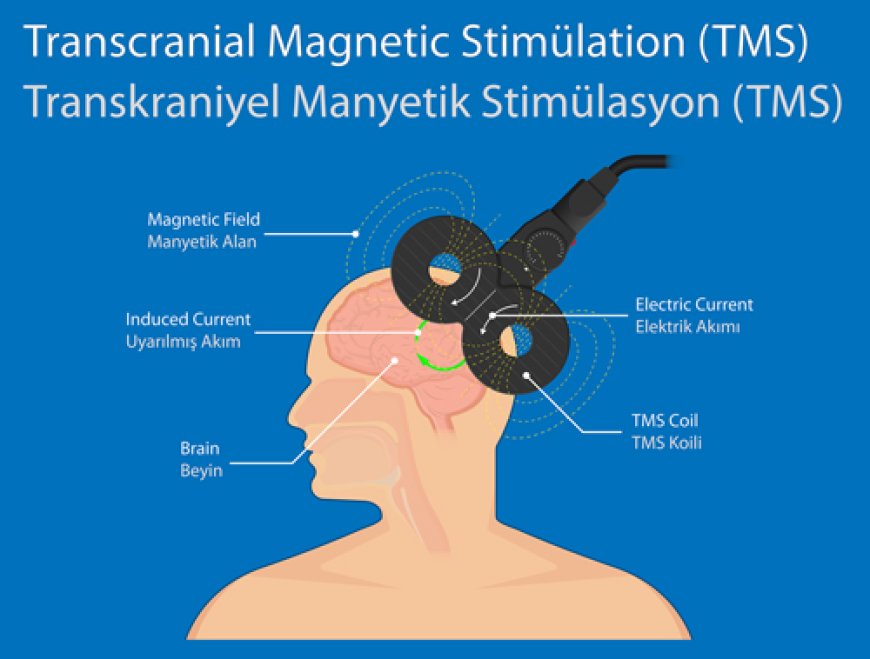TMS THERAPY IN THE TREATMENT OF OCD
"Obsessive-Compulsive Disorder (OCD) is a condition characterized by repetitive and distressing thoughts, causing anxiety and significantly impairing the individual's life by involving compulsive behavioral patterns. The primary treatment approaches for OCD are Cognitive Behavioral Therapy (CBT) and pharmacotherapy. However, in cases of high resistance, it has been observed that these treatment methods may not achieve complete recovery. Researchers have started exploring new approaches for resistant cases, and one of these treatment methods is Transcranial Magnetic Stimulation (TMS). Although there are studies demonstrating its effectiveness, research on this method is still ongoing."

The current first-line approaches in the treatment of Obsessive-Compulsive Disorder (OCD) involve Selective Serotonin Reuptake Inhibitors (SSRI) or Cognitive-Behavioral Therapy. In more resistant cases, low-dose antipsychotics and SNRI treatment methods are employed. While these widely used methods have proven to be effective treatment options, approximately 30-60% of patients cannot tolerate the side effects of medication and do not achieve complete recovery. Additionally, about 40% of OCD patients continue to exhibit specific symptoms, and in 10% of cases, recovery is not achieved (Tan et al., 2015).
Researchers have explored neurostimulation interventions for the treatment of resistant OCD cases, including repetitive Transcranial Magnetic Stimulation (rTMS), ablative stereotactic neurosurgery, and deep brain stimulation.
rTMS is a technique introduced by Barker et al. (1985), involving the non-invasive application of electromagnetic pulses to specific areas of the brain. Utilizing a non-isolated coil, an electric current is passed through it, generating a magnetic field of approximately 2 Tesla. These currents create magnetic field pulses in a localized area beneath the coil, traversing the superficial skin and skull to reach the superficial brain region (Sehn, Eslick, & Brakoulias, 2018). Consequently, it induces depolarization of cortical neurons, leading to the generation of action potentials in neurons through trans-synaptic mechanisms (Jaafari et al., 2012).
rTMS has various methods, including single-pulse, paired-pulse, and repetitive transcranial magnetic stimulation (rTMS), which involves delivering transmissions to the brain in a repetitive training manner.
As for the side effects of rTMS, they include headaches, neck and back pains, and sensations of discomfort in the scalp. Physiologically, rTMS has some negative effects, such as triggering certain seizures, which vary based on the intensity, frequency, and the individual's medical history (Wassermann, 1998; Rossi et al., 2009).
While research on rTMS therapy has primarily focused on depression, it has also been studied for conditions such as anxiety disorders, PTSD, and OCD (Jaafari et al., 2012).
When examining the neurobiology of OCD, it has been found that specific brain regions, including the caudate nucleus, Anterior Cingulate Cortex (ACC), and thalamus, are associated with emotion and cognition regulation (Whiteside, 2004). Generally, OCD is linked to a disorder in the orbitofronto-striato-pallido-thalamic circuit, which includes the Dorsolateral Prefrontal Cortex (DLPFC), ACC, Supplementary Motor Area (SMA), Orbitofrontal Cortex (OFC), medial prefrontal cortex, and basal ganglia. Neurophysiological studies have shown hyperactivity in DLPFC, SMA, and OFC in OCD patients, indicating a deficiency in response control in information processing (Sehn, Eslick, & Brakoulias, 2018). The high activity in SMA may explain the lack of control over behavior in OCD. Therefore, TMS therapy targets specific areas associated with OCD in cases that do not respond to first-line treatments and exhibit resistance.
REFERENCES
Tan, O., Hızlı Sayar, G., Önen Ünsalver, B., Arat, M. A., Karamustafalıoğlu, O. (2015). Combining transcranial magnetic stimulation and cognitive-behavioral therapy in treatment-resistant obsessive-compulsive disorder. Anadolu Psikiyatri Dergisi, 16, 180-188. doi: 10.5455/apd.160156.
Jaafari, N., Rachid, F., Yves-Rotge, J., Polosan, M., El-Hage, W., Belin, D., Vibert, N., Pelissolo, A. (2012). Safety and efficacy of repetitive transcranial magnetic stimulation in the treatment of obsessive-compulsive disorder: A review. The World Journal of Biological Psychiatry, 13:3, 164-177. DOI: 10.3109/15622975.2011.575177.
Wassermann EM. (1998). Risk and safety of repetitive transcranial magnetic stimulation: report and suggested guidelines from the International Workshop on the Safety of Repetitive Transcranial Magnetic Stimulation, Electroencephalogr Clin Neurophysiol 108(1) – 16.
Rehn, S., Eslick, D. G., Brakoulias, V. (2018). A Meta-Analysis of the Effectiveness of Different Targets Used in Repetitive Transcranial Magnetic Stimulation (rTMS) for the Treatment of Obsessive-Compulsive Disorder (OCD). Psychiatr Q, 89:645–665. https://doi.org/10.1007/s11126-018-9566-7.
What's Your Reaction?
















































































